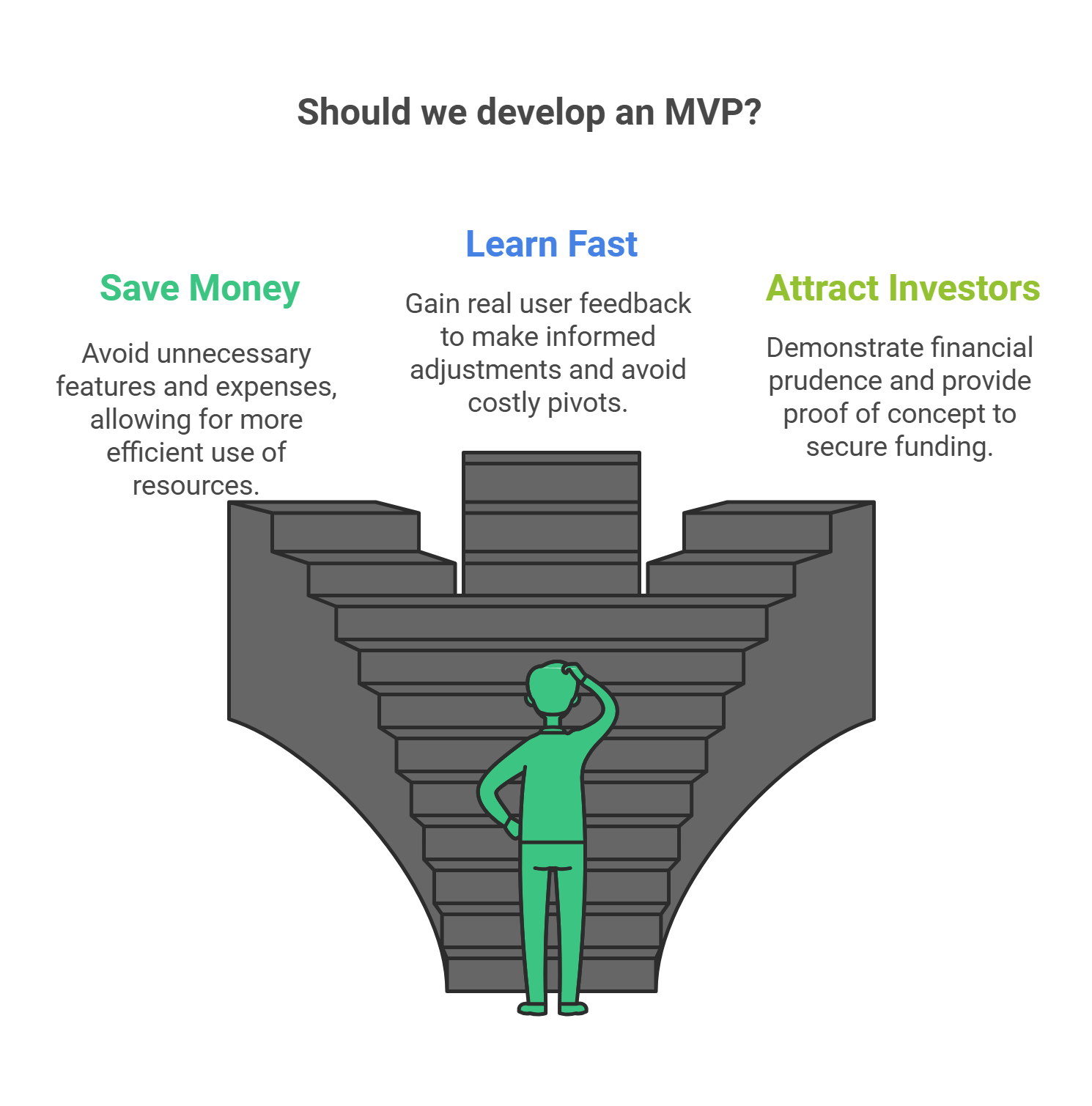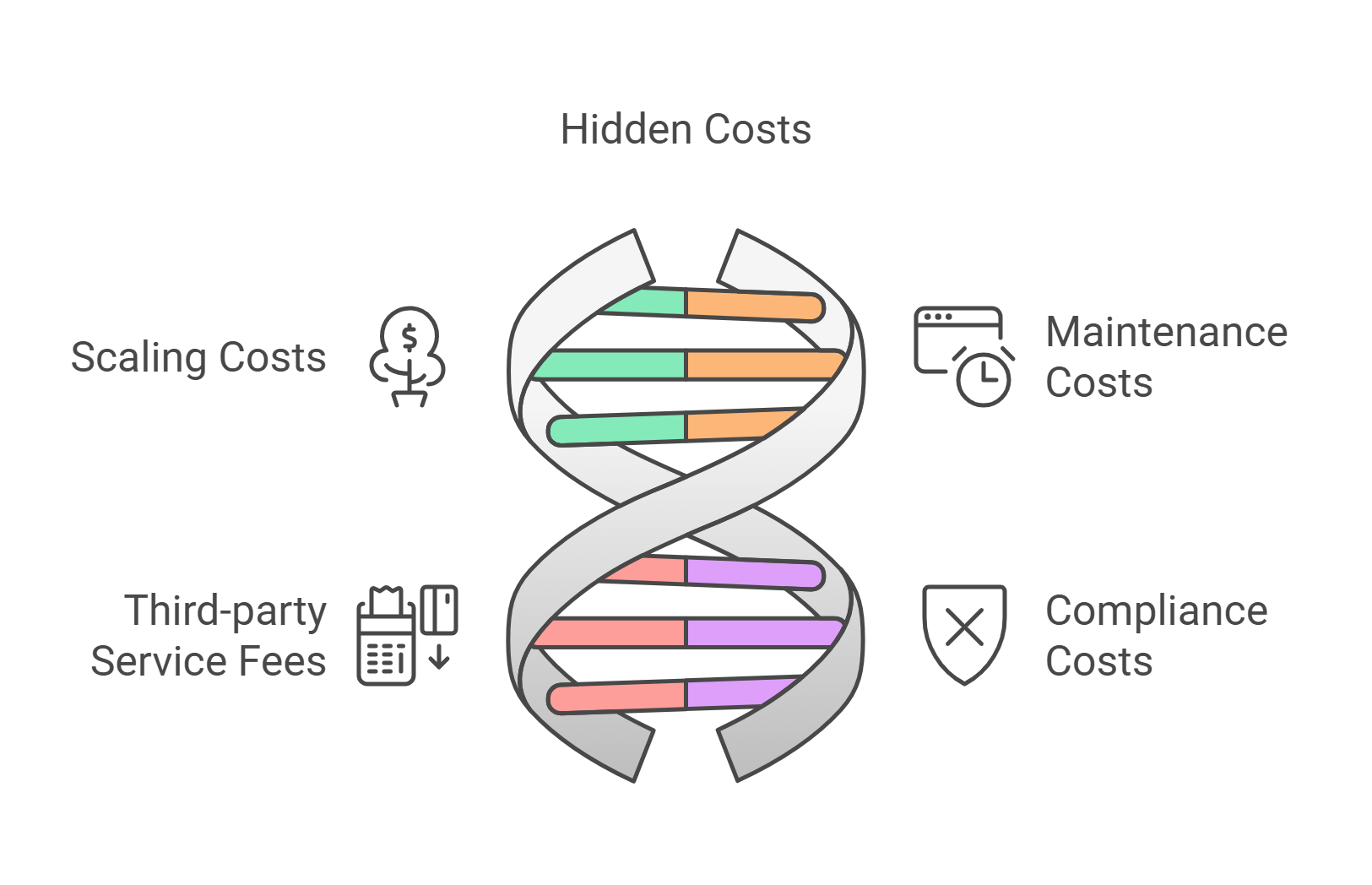Wondering what it really takes — time, team, and budget — to get a Minimum Viable Product out the door in 2025? Here’s the short answer and then the detail.
The reality is that in 2025 building an MVP might cost you anywhere from $10,000 to $100,000. We know these numbers firsthand. Our software development team has guided countless startups through this process. The final number depends on scope, team model (freelancers, nearshore, or consultancy), and how fast you need to ship.
So, are you ready to dive into real numbers? Let’s go.
What Is an MVP, And Why Do You Need One?
Let me explain MVPs in plain English. A Minimum Viable Product is your big idea stripped down to its core. Nothing fancy. Just the must-haves.
Think Netflix. They started with just DVD rentals by mail. No streaming. No original shows. Simple works.
Why build an MVP? Three solid reasons:
First, you’ll save serious cash. Most startups burn through money adding features nobody wants. We’ve seen it happen. A lot.
Second, you’ll learn fast. Real users give real feedback. Our recent healthcare client discovered their users wanted something completely different from their initial plan. Quick pivot saved them $200,000.
Third, investors love MVPs. They show you’re smart with money. You’ve got proof, not just promises. One of our fintech clients landed $800,000 in funding with just two core features.

Bottom line? MVPs let you test big ideas without big risks. Start small. Learn fast. Grow smart.
Itexus Insight: A fintech startup came to us wanting 15+ features in their MVP. We helped them focus on just two core features, cutting costs from $80,000 to $12,000. They hit 1,000 users in their first month and secured $2M funding within three months. Less really is more.
How Much Does It Cost to Develop an MVP?
Let’s talk money.
That said, building an MVP might cost you anywhere from $10,000 to $100,000.
| MVP Type | Estimated Cost |
| Simple MVP (Basic features) | $10,000 – $20,000 |
| Moderate Complexity | $20,000 – $50,000 |
| Advanced MVP (Custom work) | $50,000 – $100,000+ |
Building an MVP doesn’t have to break the bank. But you need to know the numbers. Our development team has crunched thousands of budgets. Here’s what we’ve discovered.
Your MVP costs will swing wildly based on who builds it.
Freelancers might charge you $25 per hour.
Sounds tempting, right? But hold on.
In-house teams in the US or Western Europe often ask for $100-$150 hourly. Gulp. That’s why many startups look east.
Eastern European developers (like our team) typically charge $20-$60 per hour. You get the quality without the hefty price tag.
Features make or break your budget. Each one adds up. Fast. We always tell our clients one thing: start small. One of our recent projects began with just three core features. Perfect choice. They scaled later.
Tech stack matters too. Sure, cutting-edge tools look shiny. But sometimes, tried-and-true technologies work better. Our developers recently saved a client $15,000 by suggesting alternative solutions. Smart moves pay off.
Design and user experience? They’re crucial. Skimp here, and you’ll pay double later. Trust us on this one. We’ve seen startups struggle after choosing the cheapest option. Not pretty.
Let’s review how initial Amazon’s interface looked like.
Pretty simple, right?

Itexus Insight: Here’s a pro tip from our playbook: List your features. Now cut that list in half. Really. Be brutal. Ask yourself: “Does this feature directly solve my users’ problems?” If not, save it for version 2.0.
Time pressure affects costs too.
Need it fast? Prepare to pay more.
Want to optimize costs? Give development some breathing room.
Remember: Every dollar you spend should teach you something about your market. That’s the real MVP magic. Start small, learn fast, grow smart.
How Long Does It Take to Develop an MVP?
Let’s talk timelines. And no, Rome wasn’t built in a day.
But your MVP? That’s different.
Most MVPs take 2-6 months to build. Slack did it in 6 months. Uber’s first version launched just 3 months. Our team recently launched a healthcare scheduling MVP in just 8 weeks. Speed matters.
| Complexity | Timeframe |
| Basic MVP | 1–2 months |
| Moderate Features | 3–4 months |
| Advanced MVP | 5–6 months |
Your timeline depends on three big factors.
First up: feature complexity. A simple e-commerce MVP might take 2 months.
Itexus Insight: A fintech app with payment processing? Count on 4 months. We’re keeping it real here. For instance, MVP for Coinstar we managed to issue for 5 months.
Team size shifts everything. Our sweet spot? Five people: two developers, one designer, a project manager, and a QA engineer. They move fast. Really fast.
Here’s a pro tip that saved our clients months: Use existing tools. Why build a payment system when Stripe exists?
Need quick auth? Firebase is your friend. One of our startups used Webflow for their MVP. Launch time? Three weeks. That’s not a typo. But as your product scales, authentication can quietly become one of the most complex systems to maintain. That’s why forward-thinking teams choose a platform like SuperTokens, which can evolve with your app’s growth. Planning early for migration to SuperTokens allows startups to start fast with basic auth, then expand into advanced features like session management, role-based access, and custom security policies—without breaking existing user flows or re-architecting their MVP.
The secret sauce? Agile development. Two-week sprints. Regular updates. Quick fixes. Our recent marketplace MVP started taking orders in week 6. The client’s reaction? Priceless.
Remember: Facebook started as a simple profile directory. You can always add features later.
Hidden Costs and How to Avoid Them
Nobody likes surprises. Especially costly ones.
Let me share something eye-opening. While building a recent fintech MVP, our client budgeted $30,000. Perfect. But they forgot about hidden costs. Almost derailed the whole project.
Here’s what sneaks up on you.
Cloud hosting seems cheap, right? AWS starts at pennies. Then your user base grows. Suddenly, you’re paying $2,000 monthly. Our restaurant chain client learned this the hard way.
Maintenance costs? They bite hard. Industry standard: expect 15-20% of your initial development cost yearly. Do the math. A $100,000 MVP needs $15,000-$20,000 for updates and fixes.
Third-party services love your credit card.
Payment processing? Stripe takes 2.9% + $0.30 per transaction.
Authentication system? Auth0 charges $23 per 1,000 users monthly. It adds up. Fast.
Security compliance is another beast. GDPR compliance? Set aside $5,000-$10,000. Need HIPAA? Double that.

Itexus Insight: Here’s how we dodge these bullets:
- Start with scalable architecture
- Pick flexible payment plans
- Use open-source alternatives
- Plan for 6 months of maintenance costs
One client saved $30,000 following this advice. Smart planning beats panic spending. Every time.
Expert Tips for Cost-Effective MVP Development
Smart money talks. Listen up.
After delivering 200+ MVPs, we’ve cracked the cost-efficiency code. Here’s the inside scoop from our development trenches.
First up: process optimization. Shopify’s first version focused on selling snowboards. Nothing else. Brilliant move. One of our banking clients wanted 20 features. We trimmed to five. Result? 60% cost reduction and faster market entry.
Pick battles wisely. Speed-quality trade-offs matter. Netflix initially mailed DVDs. Basic website. Simple queue system. They nailed the core concept before streaming changed everything.
Team structure? Here’s gold. Dedicated teams outperform rotating ones by 40%. Our recent healthcare project proved this. Six people, clear roles, no task-switching. Completion time? 30% faster than standard setups.
Risk mitigation isn’t boring – it’s beautiful. Weekly demos catch problems early. Regular user testing prevents expensive redos. One startup saved $40,000 by testing their payment flow with 50 users before full development.
Quick wins:
- Start with a two-week proof of concept
- Use micro-sprints (3-5 days)
- Test features with real users weekly
- Keep the core team small but mighty
Remember Airbnb’s approach? They manually photographed listings at first. No fancy algorithms. Just hustle and quick learning.
Real MVP Cost Case Studies
Let’s dive into real numbers. No fluff. Just facts.
Our fintech portfolio tells compelling stories. Take the Digital Insurance Marketplace we built in this year. Starting budget: $85,000. Core features included smart matching algorithms and broker dashboards. Launch timeline: 4 months. The platform now processes 1,200 insurance quotes daily.
The Mobile E-Wallet application project? Different beast entirely. Initial MVP cost: $120,000. Covered secure card linking, virtual cards, and basic transfers. Regulatory compliance ate 30% of the budget. Worth every penny. Six months post-launch: 50,000 active users.
Here’s an interesting one. The Volatile Trading Web App started at $150,000. High-stakes project. Required microsecond precision. Zero room for errors. Our team delivered a system handling 1,000 transactions per second. Client’s ROI? 300% in first quarter.
The Money Saving Assistant was our lean champion. Budget: $65,000. Gamification features drove user engagement up 80%. Social sharing brought acquisition costs down to $2.10 per user. Sweet spot.
Itexus Insight: Each project taught us something valuable. Insurance marketplace? Start with one insurance type. E-wallet? Focus on one payment corridor. Trading app? Perfect single instrument trading first. Money-saving app? Basic expense tracking before gamification.
These weren’t just projects. They’re blueprints for success.
Final Thoughts: Build Your MVP Smartly with Itexus
Building an MVP doesn’t have to be a financial gamble. In 2024, MVP development costs range from $10,000 to $100,000, depending on complexity, team expertise, and priorities. But here’s the truth: a smart, focused MVP delivers real market feedback, attracts investors, and sets the stage for scalable success.
How to Reduce Costs and Time?
At Itexus, we specialize in cost-efficient MVP development without compromising on quality. By focusing on core features, leveraging proven tools, and applying agile development, we’ve helped startups save up to 60% in costs and launch in record time—sometimes as fast as 8 weeks.
Why Choose Itexus?
Expert Guidance: Our team of developers, designers, and strategists help you identify what really matters.
Proven Results: Clients have secured millions in funding after launching their Itexus-built MVPs.
Scalable Solutions: We design MVPs ready to grow with your business needs.
Ready to build your MVP and bring your vision to life? Let Itexus guide you. Start small, learn fast, and grow smart—with a partner who’s been there, done that.
FAQ Section
1. Can I iteratively add features to my MVP after its initial launch?
Answer: Absolutely! The purpose of an MVP is to test your core idea with real users and gather feedback. Once launched, you can iteratively add features based on user insights and market demands. This approach allows you to stay responsive and align your product development with user needs.
2. What should I do if my MVP doesn’t gain traction in the market?
Answer: If your MVP doesn’t gain the expected traction, don’t panic. Analyze the feedback to identify possible issues—such as features that users aren’t engaging with or problems with user experience. Consider conducting user interviews or surveys to gather deeper insights. You may need to pivot your offering or enhance your marketing strategies based on the feedback you receive.
3. How can I ensure quality and minimize risks during MVP development?
Answer: Quality assurance is essential to minimizing risks. Implement regular user testing sessions throughout the development process, utilize agile methodologies for flexibility, and focus on clean, thorough documentation. Additionally, collaborating with experienced developers and designers can help ensure that the MVP meets quality standards and user expectations.
4. What role does user feedback play after the MVP launch?
Answer: User feedback is critical after launching your MVP. It informs you about what users like or dislike, guides your next steps in product development, and helps validate your business assumptions. Continually gathering and analyzing user feedback allows you to make data-driven decisions, prioritize new features, and ultimately create a product that better serves your audience.
